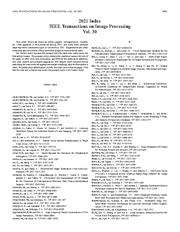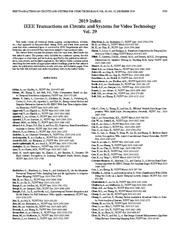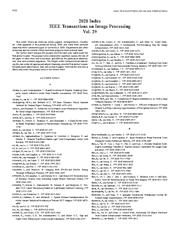A copy of this work was available on the public web and has been preserved in the Wayback Machine. The capture dates from 2020; you can also visit the original URL.
The file type is application/pdf.
Filters
Face Hallucination by Attentive Sequence Optimization with Reinforcement Learning
[article]
2019
arXiv
pre-print
Specifically, our proposed framework incorporates two components: a recurrent policy network for dynamically specifying a new attended region at each time step based on the status of the super-resolved ...
image and the past attended region sequence, and a local enhancement network for selected patch hallucination and global state updating. ...
CONCLUSION In this paper, we have proposed a deep RL-based attention mechanism to address the problem of face hallucination. ...
arXiv:1905.01509v1
fatcat:qinugepa2va2tcidnfpambfyte
Advances in deep learning for real-time image and video reconstruction and processing
2020
Journal of Real-Time Image Processing
Image reconstruction based deep learning can be efficiently performed by using neural networks, in which, weights are determined based on training data. ...
Deep learning for image reconstruction and processing is a relatively new area. ...
The authors in "A Deep Attention-based Ensemble Network for Real-time Face Hallucination", propose an end-to-end deep ensemble network that aggregates three sub-networks for extracting attention maps. ...
doi:10.1007/s11554-020-01026-2
fatcat:23jzdzkoxfdnrjfeew7bpwy7fm
Table of Contents
2020
IEEE transactions on multimedia
Tan 2723 Deep Learning for Multimedia Processing ATMFN: Adaptive-Threshold-Based Multi-Model Fusion Network for Compressed Face Hallucination . . . . . . . . . . . . . . . . . . . . . . . . . . . . . . ...
Jain 2659 Multimedia Streaming and Transport Statistical Learning Based Congestion Control for Real-Time Video Communication . . . . . . . . . . . . . . . . . . . . . . . . . . . . . . . . . . . . . . ...
doi:10.1109/tmm.2020.3020756
fatcat:low77squq5euveow7m3jjv75eq
Deep Learning-based Face Super-Resolution: A Survey
[article]
2021
arXiv
pre-print
To date, few summaries of the studies on the deep learning-based FSR are available. In this survey, we present a comprehensive review of deep learning-based FSR methods in a systematic manner. ...
Face super-resolution (FSR), also known as face hallucination, which is aimed at enhancing the resolution of low-resolution (LR) face images to generate high-resolution (HR) face images, is a domain-specific ...
for biometrics: a comprehensive survey [5] 2018 PR 6 Face hallucination techniques: a survey [6] 2018 CICT 7 Survey on GAN-based face hallucination with its model development [7] 2019 IET The ...
arXiv:2101.03749v2
fatcat:q56d2mpn4rfyzmi5fo36d2ecja
Deep Learning-based Face Super-resolution: A Survey
2023
ACM Computing Surveys
To date, few summaries of the studies on the deep learning-based FSR are available. In this survey, we present a comprehensive review of deep learning-based FSR methods in a systematic manner. ...
Face super-resolution (FSR), also known as face hallucination, which is aimed at enhancing the resolution of low-resolution (LR) face images to generate high-resolution face images, is a domain-specific ...
[187] propose a transformative adversarial neural network for joint face frontalization and hallucination. ...
doi:10.1145/3485132
fatcat:gxaod3eqs5gkbmtow3k4jrrpvy
2021 Index IEEE Transactions on Image Processing Vol. 30
2021
IEEE Transactions on Image Processing
The Author Index contains the primary entry for each item, listed under the first author's name. ...
., +, TIP 2021 8644-8657 Computer science Depth Privileged Scene Recognition via Dual Attention Hallucination. Chen, J., +, TIP 2021 9164-9178 Night-Time Scene Parsing With a Large Real Dataset. ...
., +, TIP 2021 868-877 Real-Time Deep Image Retouching Based on Learnt Semantics Dependent Global Transforms. ...
doi:10.1109/tip.2022.3142569
fatcat:z26yhwuecbgrnb2czhwjlf73qu
Face hallucination using cascaded super-resolution and identity priors
[article]
2019
arXiv
pre-print
We approach the problem with convolutional neural networks (CNNs) and propose a novel (deep) face hallucination model that incorporates identity priors into the learning procedure. ...
The model consists of two main parts: i) a cascaded super-resolution network that upscales the low-resolution images, and ii) an ensemble of face recognition models that act as identity priors for the ...
SR network for face hallucination. ...
arXiv:1805.10938v2
fatcat:sd46zusrdjconctjpwnkoqaeeq
Ensemble Super-Resolution with A Reference Dataset
[article]
2019
arXiv
pre-print
Based on the assumption that better component super-resolver should have larger ensemble weight when performing SR reconstruction, we present a Maximum A Posteriori (MAP) estimation framework for the inference ...
In this paper, we present a simple but effective single image SR method based on ensemble learning, which can produce a better performance than that could be obtained from any of SR methods to be ensembled ...
Jingang Shi, the author of [78] , for his kind providing of the source codes of DRP based face super-resolution approach. ...
arXiv:1905.04696v1
fatcat:zuoz2n2arjd7vfmok3uhjpp3fu
Face hallucination using cascaded super-resolution and identity priors
2019
IEEE Transactions on Image Processing
We approach this task with convolutional neural networks (CNNs) and propose a novel (deep) face hallucination model that incorporates identity priors into the learning procedure. ...
The model consists of two main parts: i) a cascaded super-resolution network that upscales the low-resolution facial images, and ii) an ensemble of face recognition models that act as identity priors for ...
Here, we contribute to this body of work with a novel deep face hallucination model. ...
doi:10.1109/tip.2019.2945835
pmid:31613762
fatcat:35qwxawe4ba4bajtbum2jvgu7q
Face Hallucination Revisited: An Exploratory Study on Dataset Bias
2019
2019 IEEE/CVF Conference on Computer Vision and Pattern Recognition Workshops (CVPRW)
Contemporary face hallucination (FH) models exhibit considerable ability to reconstruct high-resolution (HR) details from low-resolution (LR) face images. ...
generalization capabilities of several FH models in various scenarios where the degradation function does not match the training setup and conduct experiments with synthetically downgraded as well as real-life ...
Experiments with real LR images, on the other hand, are scarce in the literature and the usefulness of FH models for face recognition with real-world LR imagery has not received much attention by the research ...
doi:10.1109/cvprw.2019.00295
dblp:conf/cvpr/GrmPCSDS19
fatcat:lxvyyex4anhajdtiwmoaxkggnu
2020 Index IEEE Transactions on Multimedia Vol. 22
2020
IEEE transactions on multimedia
., TMM Dec. 2020 3115-3127 Jevremovic, A., see Kostic, Z., TMM July 2020 1904-1916 Ji, Q., see Wang, S., TMM April 2020 1084-1097 Jia, K., see 1345-1357 Jia, Y., see 2138-2148 Jian, M., Dong, J., ...
., +, TMM March 2020 786-794
ATMFN: Adaptive-Threshold-Based Multi-Model Fusion Network for
Compressed Face Hallucination. ...
., +, TMM June 2020 1619-1633
ATMFN: Adaptive-Threshold-Based Multi-Model Fusion Network for
Compressed Face Hallucination. ...
doi:10.1109/tmm.2020.3047236
fatcat:llha6qbaandfvkhrzpe5gek6mq
Input Dropout for Spatially Aligned Modalities
[article]
2020
arXiv
pre-print
As such many practical solutions tend to be based on simpler sensors, mostly for cost, simplicity and robustness considerations. ...
We demonstrate that Input Dropout trivially combines with existing deep convolutional architectures, and improves their performance on a wide range of computer vision tasks such as dehazing, 6-DOF object ...
We thank Nvidia Corporation for the donation of the GPUs used in this research. ...
arXiv:2002.02852v2
fatcat:2upselukyzd5vdja5qmcjaccbe
2019 Index IEEE Transactions on Circuits and Systems for Video Technology Vol. 29
2019
IEEE transactions on circuits and systems for video technology (Print)
., +, TCSVT
Aug. 2019 2521-2534
A Real-Time High-Quality Complete System for Depth Image-Based Ren-
dering on FPGA. ...
., +, TCSVT July 2019 2112-2125 Interpolation A Real-Time High-Quality Complete System for Depth Image-Based Rendering on FPGA. ...
doi:10.1109/tcsvt.2019.2959179
fatcat:2bdmsygnonfjnmnvmb72c63tja
Image Denoising with Control over Deep Network Hallucination
2022
IS&T International Symposium on Electronic Imaging Science and Technology
For better control and interpretability over a deep denoiser, we propose a novel framework exploiting a denoising network. We call it controllable confidence-based image denoising (CCID). ...
In this framework, we exploit the outputs of a deep denoising network alongside an image convolved with a reliable filter. ...
These results highlight the generalizability problem of the deep learning network, a problem that is not faced by the Gaussian filters. ...
doi:10.2352/ei.2022.34.14.coimg-217
fatcat:5lfhpcw5tvhjrn6w2unwrh7o3u
2020 Index IEEE Transactions on Image Processing Vol. 29
2020
IEEE Transactions on Image Processing
., Ensemble of Deep Convolutional Neural Networks With Gabor Face Representations for Face Recognition. ...
Abu, A., +, TIP 2020 445-460
G
Gabor filters
Ensemble of Deep Convolutional Neural Networks With Gabor Face Repre-
sentations for Face Recognition. ...
doi:10.1109/tip.2020.3046056
fatcat:24m6k2elprf2nfmucbjzhvzk3m
« Previous
Showing results 1 — 15 out of 1,154 results














